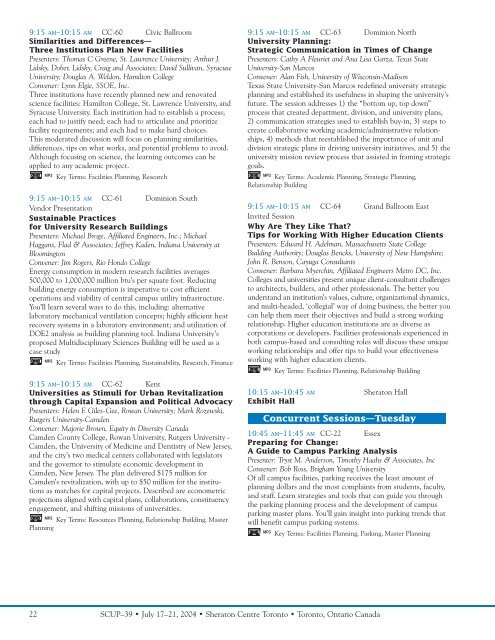Conference Brochure - Society for College and University Planning
Conference Brochure - Society for College and University Planning
Conference Brochure - Society for College and University Planning
- No tags were found...
Create successful ePaper yourself
Turn your PDF publications into a flip-book with our unique Google optimized e-Paper software.
9:15 AM–10:15 AM CC-60 Civic BallroomSimilarities <strong>and</strong> Differences—Three Institutions Plan New FacilitiesPresenters: Thomas C Greene, St. Lawrence <strong>University</strong>; Arthur J.Lidsky, Dober, Lidsky, Craig <strong>and</strong> Associates; David Sullivan, Syracuse<strong>University</strong>; Douglas A. Weldon, Hamilton <strong>College</strong>Convener: Lynn Elgie, SSOE, Inc.Three institutions have recently planned new <strong>and</strong> renovatedscience facilities: Hamilton <strong>College</strong>, St. Lawrence <strong>University</strong>, <strong>and</strong>Syracuse <strong>University</strong>. Each institution had to establish a process;each had to justify need; each had to articulate <strong>and</strong> prioritizefacility requirements; <strong>and</strong> each had to make hard choices.This moderated discussion will focus on planning similarities,differences, tips on what works, <strong>and</strong> potential problems to avoid.Although focusing on science, the learning outcomes can beapplied to any academic project.Key Terms: Facilities <strong>Planning</strong>, Research9:15 AM–10:15 AM CC-61 Dominion SouthVendor PresentationSustainable Practices<strong>for</strong> <strong>University</strong> Research BuildingsPresenters: Michael Broge, Affiliated Engineers, Inc.; MichaelHaggans, Flad & Associates; Jeffrey Kaden, Indiana <strong>University</strong> atBloomingtonConvener: Jim Rogers, Rio Hondo <strong>College</strong>Energy consumption in modern research facilities averages500,000 to 1,000,000 million btu’s per square foot. Reducingbuilding energy consumption is imperative to cost efficientoperations <strong>and</strong> viability of central campus utility infrastructure.You’ll learn several ways to do this, including: alternativelaboratory mechanical ventilation concepts; highly efficient heatrecovery systems in a laboratory environment; <strong>and</strong> utilization ofDOE2 analysis as building planning tool. Indiana <strong>University</strong>’sproposed Multidisciplinary Sciences Building will be used as acase studyKey Terms: Facilities <strong>Planning</strong>, Sustainability, Research, Finance9:15 AM–10:15 AM CC-62 KentUniversities as Stimuli <strong>for</strong> Urban Revitalizationthrough Capital Expansion <strong>and</strong> Political AdvocacyPresenters: Helen F. Giles-Gee, Rowan <strong>University</strong>; Mark Rozewski,Rutgers <strong>University</strong>-CamdenConvener: Majorie Brown, Equity in Diversity CanadaCamden County <strong>College</strong>, Rowan <strong>University</strong>, Rutgers <strong>University</strong> -Camden, the <strong>University</strong> of Medicine <strong>and</strong> Dentistry of New Jersey,<strong>and</strong> the city’s two medical centers collaborated with legislators<strong>and</strong> the governor to stimulate economic development inCamden, New Jersey. The plan delivered $175 million <strong>for</strong>Camden’s revitalization, with up to $50 million <strong>for</strong> the institutionsas matches <strong>for</strong> capital projects. Described are econometricprojections aligned with capital plans, collaborations, constituencyengagement, <strong>and</strong> shifting missions of universities.Key Terms: Resources <strong>Planning</strong>, Relationship Building, Master<strong>Planning</strong>9:15 AM–10:15 AM CC-63 Dominion North<strong>University</strong> <strong>Planning</strong>:Strategic Communication in Times of ChangePresenters: Cathy A Fleuriet <strong>and</strong> Ana Lisa Garza, Texas State<strong>University</strong>-San MarcosConvener: Alan Fish, <strong>University</strong> of Wisconsin-MadisonTexas State <strong>University</strong>-San Marcos redefined university strategicplanning <strong>and</strong> established its usefulness in shaping the university’sfuture. The session addresses 1) the “bottom up, top down”process that created department, division, <strong>and</strong> university plans,2) communication strategies used to establish buy-in, 3) steps tocreate collaborative working academic/administrative relationships,4) methods that reestablished the importance of unit <strong>and</strong>division strategic plans in driving university initiatives, <strong>and</strong> 5) theuniversity mission review process that assisted in framing strategicgoals.Key Terms: Academic <strong>Planning</strong>, Strategic <strong>Planning</strong>,Relationship Building9:15 AM–10:15 AM CC-64 Gr<strong>and</strong> Ballroom EastInvited SessionWhy Are They Like That?Tips <strong>for</strong> Working With Higher Education ClientsPresenters: Edward H. Adelman, Massachusetts State <strong>College</strong>Building Authority; Douglas Bencks, <strong>University</strong> of New Hampshire;John R. Benson, Cayuga ConsultantsConvener: Barbara Myerchin, Affiliated Engineers Metro DC, Inc.<strong>College</strong>s <strong>and</strong> universities present unique client-consultant challengesto architects, builders, <strong>and</strong> other professionals. The better youunderst<strong>and</strong> an institution’s values, culture, organizational dynamics,<strong>and</strong> multi-headed, ‘collegial’ way of doing business, the better youcan help them meet their objectives <strong>and</strong> build a strong workingrelationship. Higher education institutions are as diverse ascorporations or developers. Facilities professionals experienced inboth campus-based <strong>and</strong> consulting roles will discuss these uniqueworking relationships <strong>and</strong> offer tips to build your effectivenessworking with higher education clients.Key Terms: Facilities <strong>Planning</strong>, Relationship Building10:15 AM–10:45 AM Sheraton HallExhibit Hall10:45 AM–11:45 AM CC-22 EssexPreparing <strong>for</strong> Change:A Guide to Campus Parking AnalysisPresenter: Tryst M. Anderson, Timothy Haahs & Associates, IncConvener: Bob Ross, Brigham Young <strong>University</strong>Of all campus facilities, parking receives the least amount ofplanning dollars <strong>and</strong> the most complaints from students, faculty,<strong>and</strong> staff. Learn strategies <strong>and</strong> tools that can guide you throughthe parking planning process <strong>and</strong> the development of campusparking master plans. You’ll gain insight into parking trends thatwill benefit campus parking systems.Key Terms: Facilities <strong>Planning</strong>, Parking, Master <strong>Planning</strong>22 SCUP–39 • July 17–21, 2004 • Sheraton Centre Toronto • Toronto, Ontario Canada
















